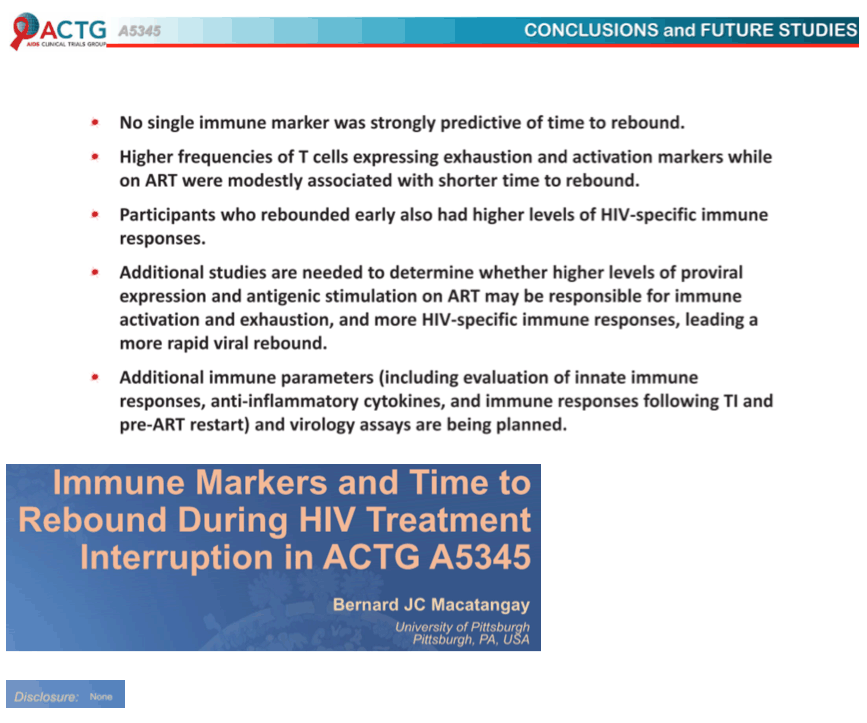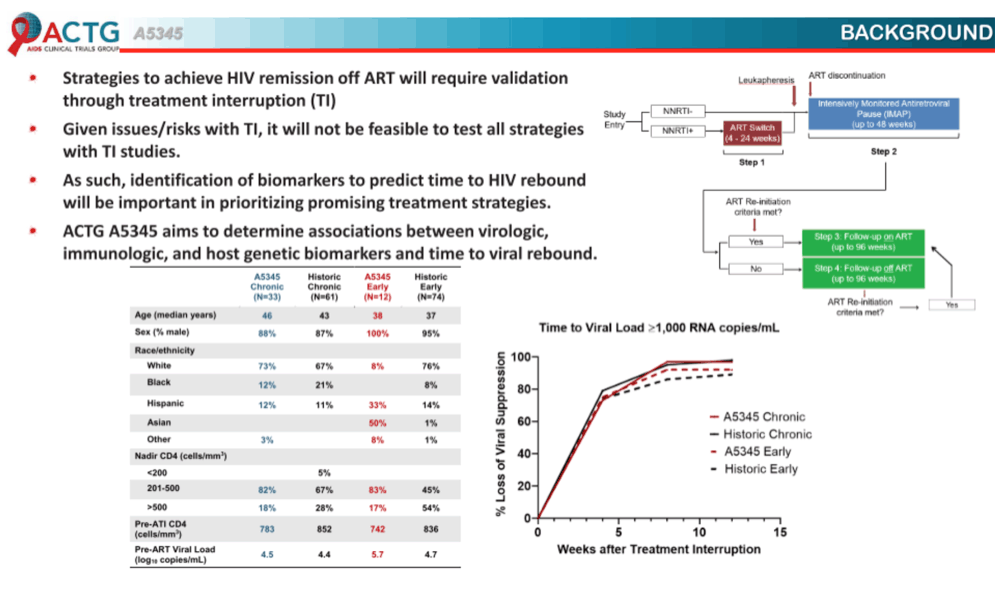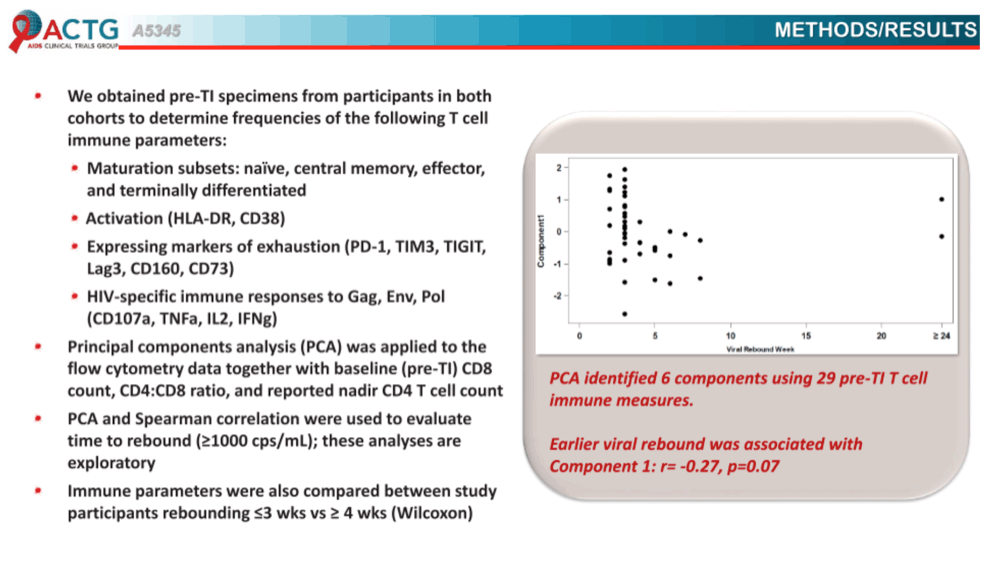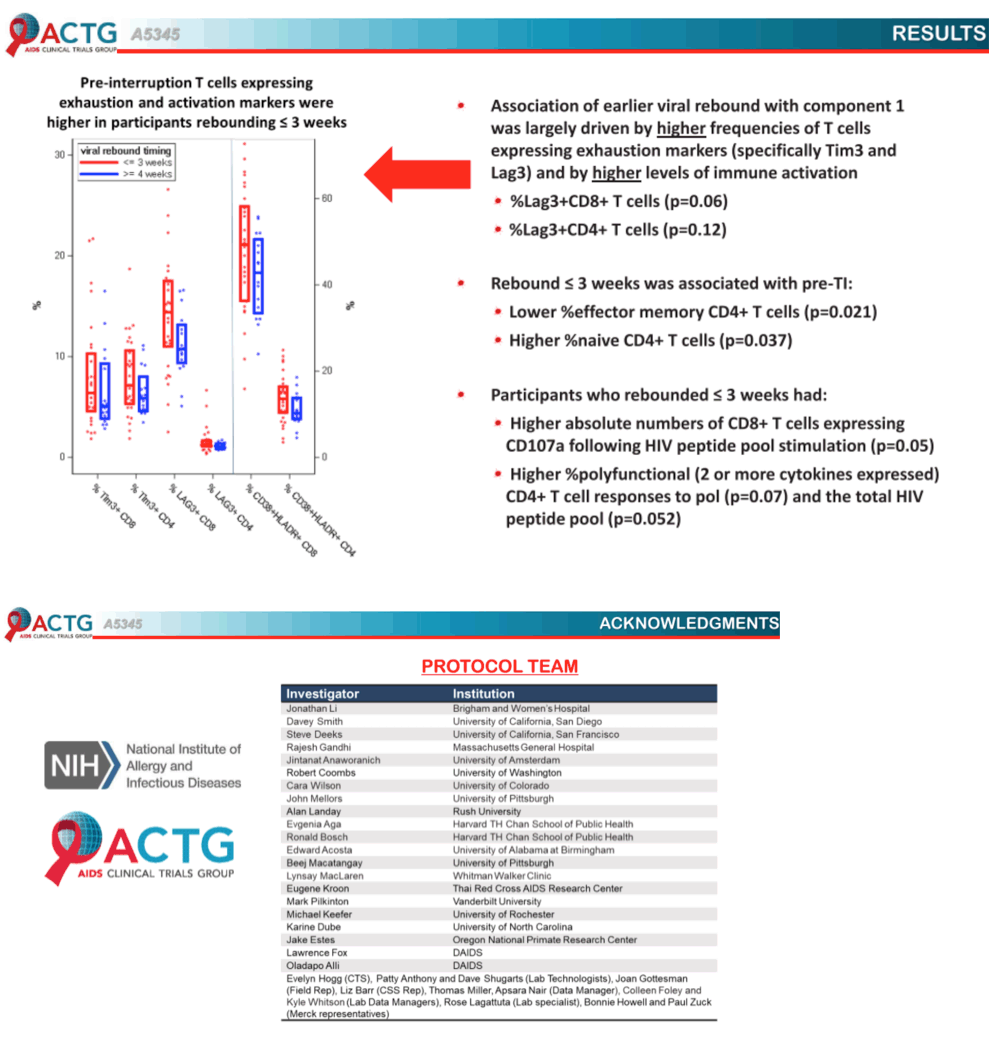 |
 |
 |
| |
IMMUNE MARKERS AND TO TIME TO REBOUND DURING HIV TREATMENT INTERRUPTION IN ACTG A5345
|
| |
| |
CROI 2021 March 6-10 Reported by Jules Levin
Bernard Macatangay1, Jonathan Li2, Evgenia Aga3, Ronald J. Bosch3, Jennifer Kinslow4, Mark Plinkton5, Lynsay MacLaren Ehui6, Eugene Kroon7, Jintanat Ananworanich8, Robert Coombs9, John W. Mellors1, Steven G. Deeks10, Rajesh T. Gandhi11, Davey M. Smith12, Alan Landay13
1University of Pittsburgh, Pittsburgh, PA, USA, 2Brigham and Women's Hospital, Boston, MA, USA, 3Harvard TH Chan School of Public Health, Boston, MA, USA, 4Rush University, Chicago, IL, USA, 5Vanderbilt University, Nashville, TN, USA, 6Whitman- Walker Health, Washington, DC, USA, 7Thai Red Cross AIDS Research Centre, Bangkok, Thailand, 8Amsterdam Institute for Global Health and Development, Amsterdam, Netherlands, 9University of Washington, Seattle, WA, USA, 10University of California San Francisco, San Francisco, CA, USA, 11Massachusetts General Hospital, Boston,
MA, USA, 12University of California San Diego, San Diego, CA, USA, 13Rush University Medical Center, Chicago, IL, USA
program abstract
Background: Understanding factors that affect viral rebound timing during antiretroviral treatment interruption will accelerate efforts toward inducing sustained HIV remission. We evaluated whether immunologic parameters prior to treatment interruption are predictive of time to rebound in individuals interrupting ART in a highly monitored setting.
Methods: A5345 enrolled individuals who started ART in chronic or early infection and who were virally suppressed on ART for ≥2 yrs. Using flow cytometry, we evaluated frequencies of T cell maturation subsets, levels of T cell activation (HLA-DR+CD38+), exhaustion (PD-1, TIM3, TIGIT, LAG3, and CD160), and HIV-specific T cell polyfunctional responses (CD107a, TNFa, IL2, and IFNg) to gag, pol, and env peptide pools. Principal component analysis (PCA) and Spearman correlation were used to evaluate time to rebound (≥1000 cps/mL), and parameters were compared between participants rebounding ≤ 3wks vs. ≥ 4wks (Wilcoxon).
Results: Of the 45 analyzed participants, 33 were treated in chronic infection. There were no consistent differences in the immune parameters between early and chronic-treated participants. Higher frequencies of T cells expressing activation and exhaustion markers via PCA were modestly associated with shorter time to viral rebound (r =-0.27, p=0.07) whereas none of the HIV-specific immune parameters correlated with viral rebound. 29 and 16 participants had viral rebound ≤3wks and ≥4wks, respectively. The two groups did not differ in terms of levels of T cell activation and exhaustion, except for a trend for lower %LAG3+CD8+ T cells in the ≥4wk group (p=0.06). The ≥4wk group also had greater %effector memory CD4+ T cells (p=0.021) but lower %naive CD4+ T cells (p=0.037). The ≥4wk group had lower absolute numbers of total CD8+ T cells expressing CD107a following HIV peptide pool stimulation (p=0.05), and trends for lower % polyfunctional CD4+ T cell responses to pol (p=0.07), env (p=0.06) and total HIV peptide pool (p=0.052).
Conclusion: Although no single immune marker was strongly predictive of time to rebound, higher levels of T cell activation and exhaustion while on ART are modestly associated with shorter time to rebound. In addition, those with early viral rebound had higher levels of on-ART HIV-specific T cells. Additional studies are needed to evaluate whether higher levels of proviral expression and antigenic stimulation on ART may be responsible for immune stimulation, exhaustion and more rapid viral rebound after treatment interruption.
Final Data Presentation




|
| |
|
 |
 |
|
|